Post by 90GTVert on Feb 15, 2011 12:53:08 GMT -5
**Airbox modifications often require jetting and/or adjustments to the carburetor to compensate for increased airflow. Failure to do so could lead to engine damage.**
Here's the airbox commonly found on 139QMB / GY6 50cc equipped Chinese scooters.
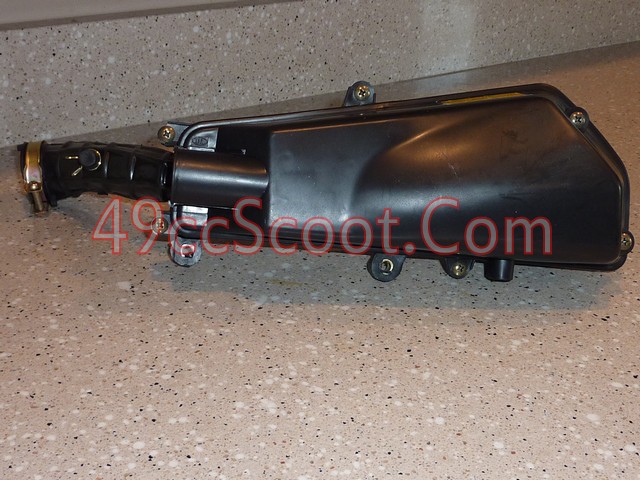
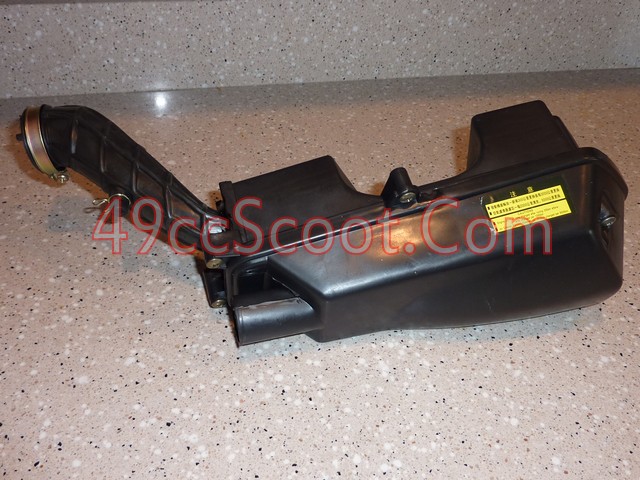
It's not a bad design, but it does come with some restrictions in stock form. The easiest to deal with involve the air inlet tube. This airbox did not have one, but some come with a cap on the air inlet of the airbox. The cap often has small holes that would restrict flow into the airbox. That cap can be removed.
Even with no cap present, you can see in the image below that the inlet becomes much smaller than the initial opening. The opening begins at about 28-29mm and is restricted down to about 19mm before entering the airbox.
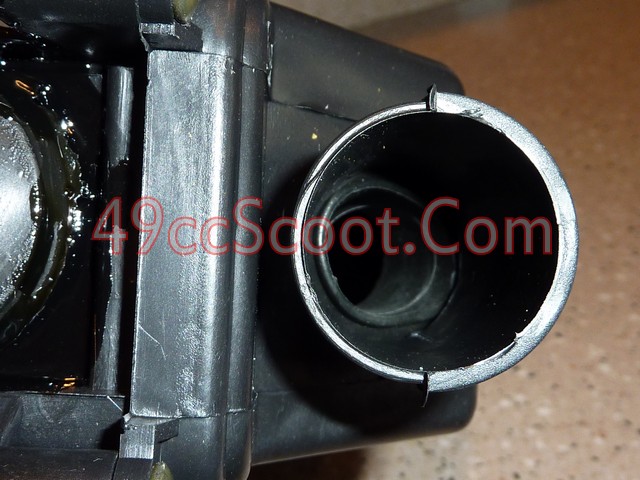
Luckily, this little restriction can be easily removed. Begin by removing the screws that hold the two halves of the airbox together.
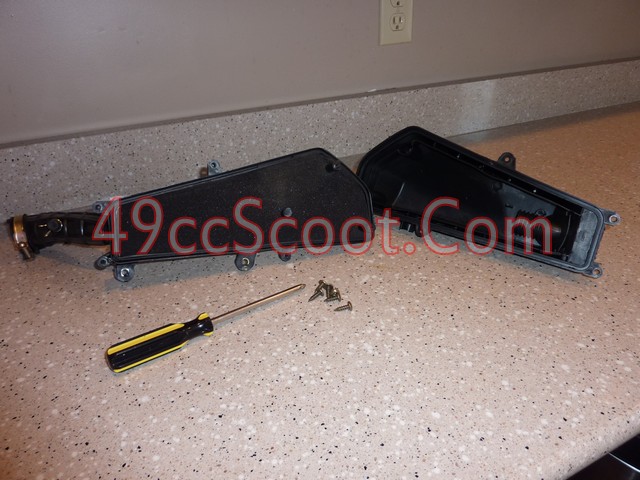
Now you should be able to see the little restrictor tube that is placed in the front half of the airbox. It will should easily slide up and out of the airbox, leaving a much larger inlet.
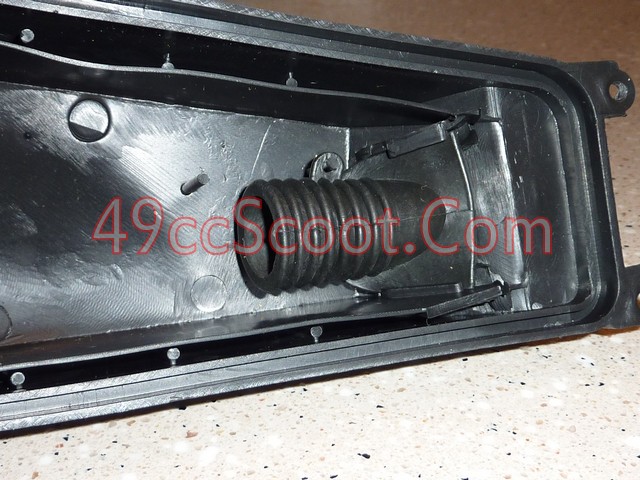
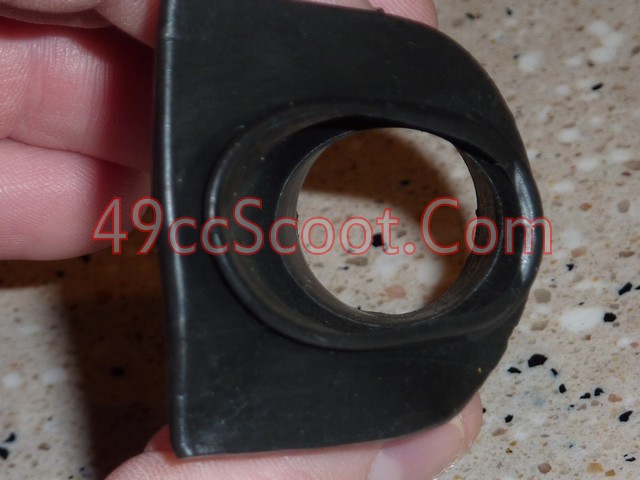
That's the most basic de-restriction for a stock airbox, but it can be taken farther. I don't really think going beyond the basics will show much benefit for the effort involved unless a larger carburetor is used, but I have not tried it on this model of airbox to know for sure.
The tube that passes from the outlet of the airbox to the inlet of the carburetor obviously changes dimensions.
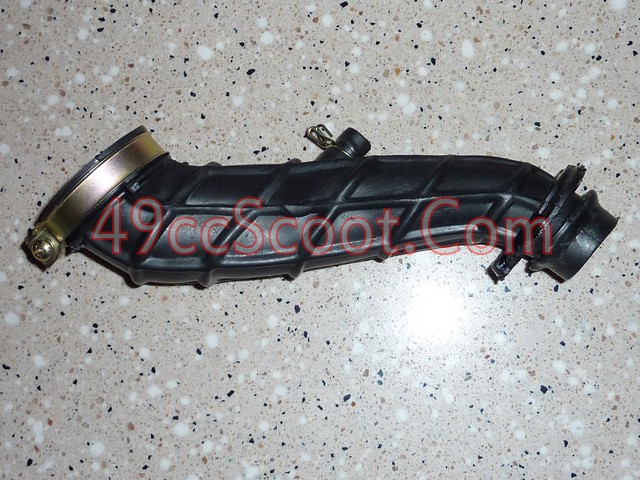
It exits the airbox at around 19mm, and expands to 38-39 where it mounts to the carburetor's mouth. I initially thought that perhaps it was some sort of an attempt to create a venturi effect, but I've come to think that it's more of a restriction than anything else when more airflow is needed for larger carburetors or displacements. I'm sure not an expert on airboxes or airflow, so I may be wrong again. Regardless, I'm sharing this info so anyone that desires can experiment.
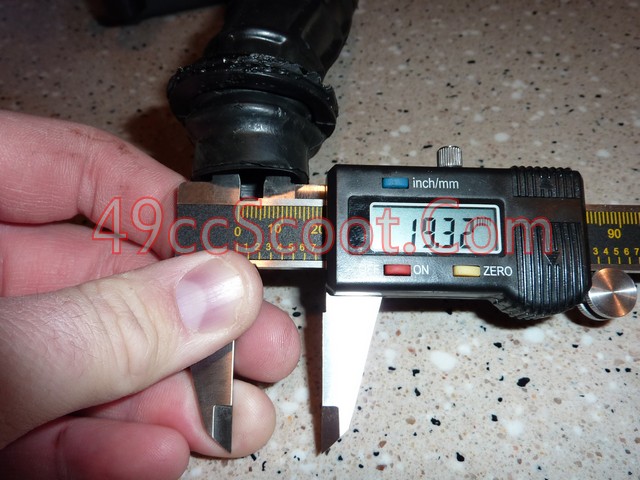
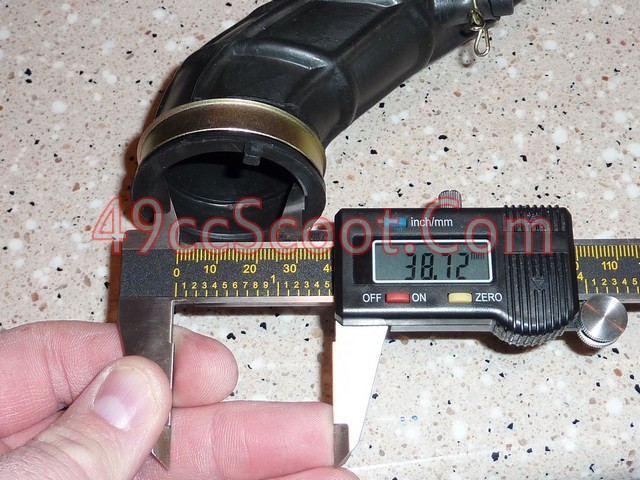
With the filter removed from the rear half of the airbox, you can see this small outlet.
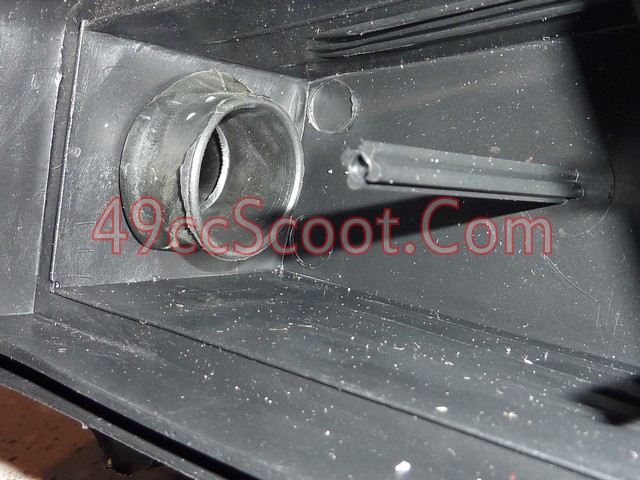
The easiest way to deal with this would be to replace the stock outlet hose with a hose of a constant diameter that mates up to the carburetor mouth. Blower/vacuum tubing with a 1.5" inside diameter could work well for this purpose and should fit over the stock carburetor's mouth for an easy clamp-on connection.
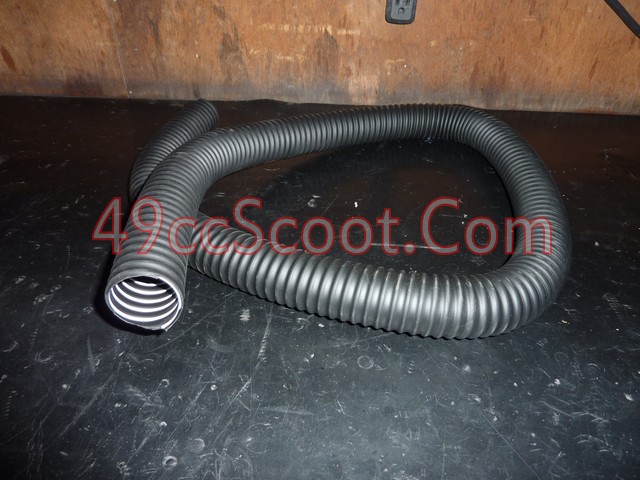
I have not performed this modification to the 139QMB airbox yet, but I have done it to a two-stroke scooter's airbox. The process would be much the same, although you would need to enlarge the opening of the airbox a little to make the large hose work as I did it for my two-stroke. Below is a link to that information.
49ccscoot.proboards.com/index.cgi?board=carb&action=display&thread=1346
Since it's a different setup, here's how you would remove the old inlet tube from the GY6 airbox. The tube usually has a gooey sealant around it.
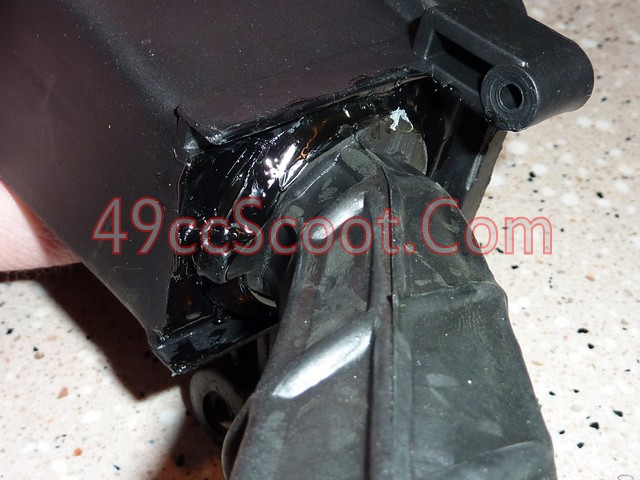
You can use a flat screwdriver or a knife of some sort to cut or free the tube from the sealant.
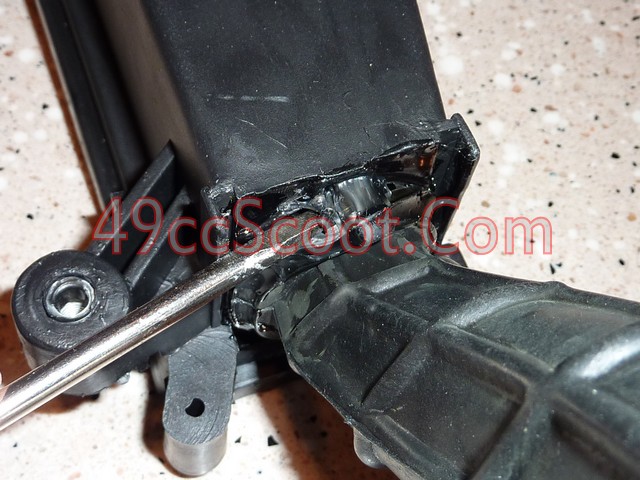
Then, move inside the airbox and use a small flat screwdriver to begin working the tube out. Use gentle pressure to avoid damaging the airbox. Once that's mostly free, just pull it out.
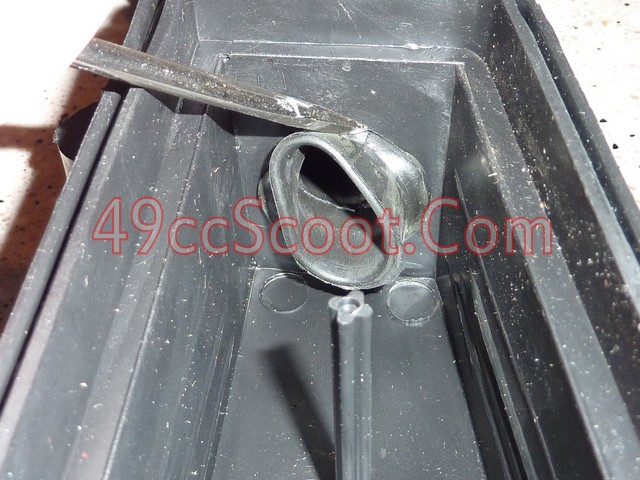
The stock foam filter appears to be a fairly free-flowing filter, but if you wish to take all of this another step farther you may want to look into an aftermarket filter sheet. I don't believe anyone makes a pre-cut drop-in filter for the 139QMB airbox at this point, but you can make your own. UNI and other filter manuafacturers sell sheets of different types of foam filter material that can be cut to fit in the stock airbox.
Here's the airbox commonly found on 139QMB / GY6 50cc equipped Chinese scooters.


It's not a bad design, but it does come with some restrictions in stock form. The easiest to deal with involve the air inlet tube. This airbox did not have one, but some come with a cap on the air inlet of the airbox. The cap often has small holes that would restrict flow into the airbox. That cap can be removed.
Even with no cap present, you can see in the image below that the inlet becomes much smaller than the initial opening. The opening begins at about 28-29mm and is restricted down to about 19mm before entering the airbox.

Luckily, this little restriction can be easily removed. Begin by removing the screws that hold the two halves of the airbox together.

Now you should be able to see the little restrictor tube that is placed in the front half of the airbox. It will should easily slide up and out of the airbox, leaving a much larger inlet.


That's the most basic de-restriction for a stock airbox, but it can be taken farther. I don't really think going beyond the basics will show much benefit for the effort involved unless a larger carburetor is used, but I have not tried it on this model of airbox to know for sure.
The tube that passes from the outlet of the airbox to the inlet of the carburetor obviously changes dimensions.

It exits the airbox at around 19mm, and expands to 38-39 where it mounts to the carburetor's mouth. I initially thought that perhaps it was some sort of an attempt to create a venturi effect, but I've come to think that it's more of a restriction than anything else when more airflow is needed for larger carburetors or displacements. I'm sure not an expert on airboxes or airflow, so I may be wrong again. Regardless, I'm sharing this info so anyone that desires can experiment.


With the filter removed from the rear half of the airbox, you can see this small outlet.

The easiest way to deal with this would be to replace the stock outlet hose with a hose of a constant diameter that mates up to the carburetor mouth. Blower/vacuum tubing with a 1.5" inside diameter could work well for this purpose and should fit over the stock carburetor's mouth for an easy clamp-on connection.

I have not performed this modification to the 139QMB airbox yet, but I have done it to a two-stroke scooter's airbox. The process would be much the same, although you would need to enlarge the opening of the airbox a little to make the large hose work as I did it for my two-stroke. Below is a link to that information.
49ccscoot.proboards.com/index.cgi?board=carb&action=display&thread=1346
Since it's a different setup, here's how you would remove the old inlet tube from the GY6 airbox. The tube usually has a gooey sealant around it.

You can use a flat screwdriver or a knife of some sort to cut or free the tube from the sealant.

Then, move inside the airbox and use a small flat screwdriver to begin working the tube out. Use gentle pressure to avoid damaging the airbox. Once that's mostly free, just pull it out.

The stock foam filter appears to be a fairly free-flowing filter, but if you wish to take all of this another step farther you may want to look into an aftermarket filter sheet. I don't believe anyone makes a pre-cut drop-in filter for the 139QMB airbox at this point, but you can make your own. UNI and other filter manuafacturers sell sheets of different types of foam filter material that can be cut to fit in the stock airbox.

